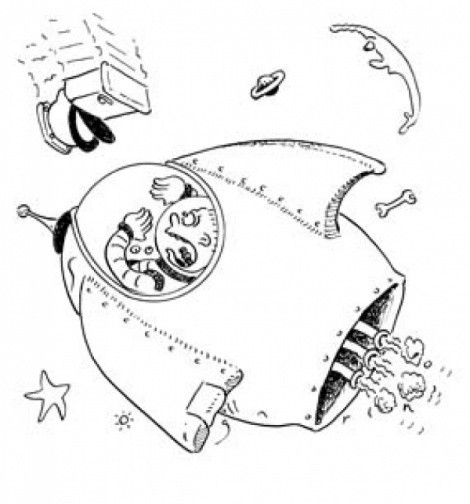
As I stare into the beautiful dark sky above my home in Hawaii and see all the stars and satellites, I ponder the possibility of “space accidents.” With all those satellites up there, are there any collisions? I don’t suppose anybody is handing out OUIs (for orbiting under the influence), but how do they decide what satellite should go where? Who oversees all those orbits? Is it just a stellar free-for-all? —Roy Orbits Son
nNo, but it’s not iron discipline either. To date, we’ve been content to let just about anybody heave stuff into orbit, requiring only minimal reporting for most launches. But with increasing commercialization of space, things are starting to get crowded up there—the Union of Concerned Scientists lists 898 active satellites, operated by everybody from the U.S. to Luxembourg. Given the vastness of space, even in earth’s immediate vicinity, it’s not like we’re talking bumper-to-bumper traffic.
nBut consider:
n1. Those 898 satellites constitute only a fraction of orbiting objects. The North American Air Defense Command (NORAD) currently tracks about 13,000 spaceborne items, mostly junk. It’s likely hundreds of thousands more bits have escaped detection.
n2. Satellites are expensive—the huge ones, like Europe’s Envisat, can cost billions, and just putting something, anything, into orbit is likely to run you (per one NASA estimate) between $50 million and $400 million.
n3. Orbiting objects travel at tens of thousands of miles per hour. If two of them collide, they’re both going to be moving at a good clip, so the net impact speed of a glancing blow won’t necessarily be that high. But even if something merely sideswipes your $500 million orbiting investment, chances are it’s hosed.
nIn short, the day may not be far off when we’ll need space traffic control—and, in fact, people have been thinking along these lines for a long time. In 1959, the United Nations recommended that rules be drawn up for handling run-ins among spacecraft, but no detailed regulations yet exist. The 1974 Convention on Registration of Objects Launched Into Outer Space requires signatory nations to report their space launch details to the UN. Presumably all do, but where they actually put the spacecraft is still up to their individual space agencies. There’s no international regulation on where low-earth satellites—those orbiting at less than about 1,200 miles up—can operate.
nNot-so-low-earth satellites are a different story. I speak here of geostationary satellites, which travel in a special orbit that allows them to remain in a fixed location relative to the earth’s surface—a handy thing for communications and weather gear. The geostationary orbit is a relatively narrow ring about 22,300 miles above the equator. Because you need two degrees of separation between satellites to avoid radio interference, there are only 180 slots available. You can put multiple satellites in the same slot as long as they use different frequencies; nonetheless, these slots are a coveted commodity. Seeing a chance to cash in, a group of equatorial countries issued the Bogota Declaration in 1976, claiming jurisdiction over the space above their countries. But as I’ve mentioned before, the declaration has been largely ignored, since the countries have no way to enforce it. Instead, the International Telecommunications Union, a UN agency, decides geostationary claims. For example, circa 1990, the tiny island nation of Tonga tried to reserve 16-plus slots for itself, possibly for speculative resale; other countries complained to the ITU, and Tonga settled for 6.
nA bigger challenge is space debris—defunct satellites, booster rocket parts, and fragments of both. Mere regulation won’t accomplish much—a lot of this stuff has been bouncing around the spaceways for decades. Hundreds of close calls happen each day:
n• In December 1991, debris from the Russian Cosmos 926 satellite hit the Cosmos 1934, an event that went unnoticed at the time and was only detected years later on analysis of old tracking data.
n• In July 1996, a small French satellite called Cerise suddenly started tumbling in orbit. The cause? A piece of space debris from an old U.S. rocket hit Cerise’s stabilizing boom at over 31,000 mph. Amazingly, the satellite recovered and completed its mission.
n• In January, 2005, a piece of a Chinese rocket had a high-level meeting with a 31-year-old U.S. rocket booster, scattering new debris.
nThese impacts were in relatively low orbits, but even high orbits can be hazardous. In March 2006, a Russian telecommunications satellite in geostationary orbit was irreparably damaged following apparent impact with an unknown object. The same thing had seemingly happened to a geostationary European communications satellite in 1993.
nSo the forthcoming space traffic control agency has its work cut out for it. I’ll volunteer to get on the horn with Luxembourg—nobody can tell me those jamokes need 16 satellites. But random debris is a tougher nut, and space cops alone won’t crack it. Someday we’ll need orbital street-sweeping, too.
nComments, questions? Take it up with Cecil on the Straight Dope Message Board, StraightDope.com, or write him at the Chicago Reader, 11 E. Illinois, Chicago 60611. tttt